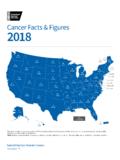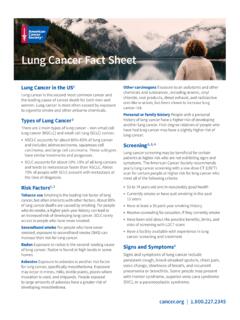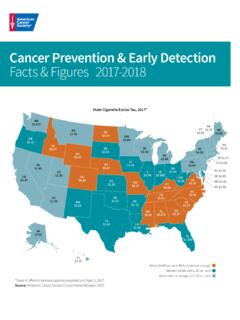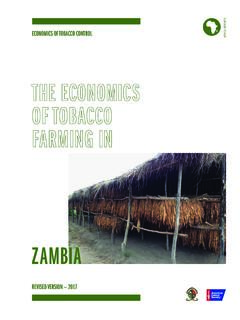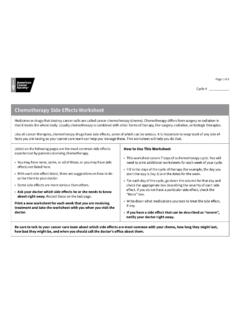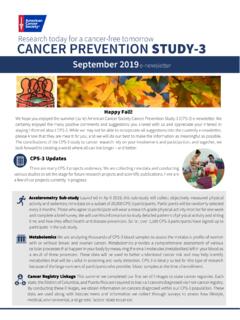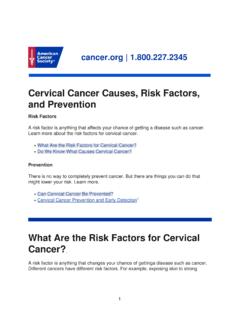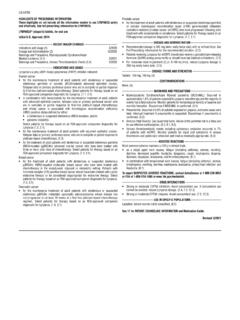Transcription of Breast Cancer Facts & Figures 2017-2018
1 Breast CancerFac t s & Figures 2017-2018 ContentsBreast Cancer Basic Facts 1 Table 1. Estimated New Female Breast Cancer Cases and Deaths by Age, US, 2017 1 Figure 1. Age-specific Female Breast Cancer Incidence Rates by Race/Ethnicity, 2010-2014, US 2 Breast Cancer Occurrence 3 Table 2. Age-specific Probability of Developing Invasive Breast Cancer for US Women 4 Figure 2. Female Breast Cancer Incidence (2010-2014) and Mortality (2011-2015) Rates by Race/Ethnicity, US 4 Figure 3. Female Breast Cancer Incidence Rates by Subtype and Race/Ethnicity, 2010-2014, US 5 Table 3. Female Breast Cancer Incidence (2010-2014) and Mortality (2011-2015) Rates by Race/Ethnicity and State 6 Figure 4. Geographic Variation in Female Breast Cancer Death Rates by Race, 2011-2015 7 Figure 5. Trends in Incidence Rates of Invasive and In Situ Female Breast Cancer by Age, 1975-2014, US 8 Figure 6a. Trends in Female Breast Cancer Incidence Rates by Race/Ethnicity, 1975-2014, US 9 Figure 6b.
2 Trends in Female Breast Cancer Death Rates by Race/Ethnicity, 1975-2015, US 9 Figure 7. Trends in Female Breast Cancer Incidence Rates by Tumor Size, 1992-2014, US 9 Figure 8. Trends in Female Breast Cancer Incidence Rates by Stage and Race/Ethnicity, 1992-2014, US 10 Figure 9. Female Breast Cancer -specific Survival and Stage Distribution by Race/Ethnicity, 2007-2013, US 11 Figure 10. Trends in Female Breast Cancer 5-year Relative Survival Rates by Race, 1975-2013, US 11 Breast Cancer Risk Factors 12 Table 4. Factors That Increase the Relative Risk for Breast Cancer in Women 13 Breast Cancer Screening 19 Table 5. Prevalence of Mammography (%), Women 40 and Older, US, 2015 21 Table 6. Prevalence of Mammography* (%) by State, Women 40 and Older, 2014 23 Breast Cancer Treatment 24 Figure 11. Female Breast Cancer Treatment Patterns (%), by Stage, 2013, US 25 What Is the American Cancer Society Doing About Breast Cancer ? 28 Sources of Statistics 32 References 33 Global Headquarters: American Cancer Society Inc.
3 250 Williams Street, NW, Atlanta, GA 30303-1002 404-320-3333 2017, American Cancer Society, Inc. All rights reserved, including the right to reproduce this publication or portions thereof in any written permission, address the Legal department of the American Cancer Society, 250 Williams Street, NW, Atlanta, GA publication attempts to summarize current scientific information about Breast Cancer . Except when specified, it does not represent the official policy of the American Cancer citation: American Cancer Society. Breast Cancer Facts & Figures 2017-2018 . Atlanta: American Cancer Society, Inc. Cancer Facts & Figures 2017-2018 1 Breast Cancer Basic FactsWhat is Breast Cancer ? Cancer is a group of diseases that cause cells in the body to change and spread out of control. Most types of Cancer cells eventually form a lump or mass called a tumor, and are named after the part of the body where the tumor originates. Most Breast cancers begin either in the Breast tissue made up of glands for milk production, called lobules, or in the ducts that connect the lobules to the nipple.
4 The remainder of the Breast is made up of fatty, connective, and lymphatic are the signs and symptoms of Breast Cancer ? Breast Cancer typically produces no symptoms when the tumor is small and most easily treated, which is why screening is important for early detection. The most common physical sign is a painless lump. Sometimes Breast Cancer spreads to underarm lymph nodes and causes a lump or swelling, even before the original Breast tumor is large enough to be felt. Less common signs and symptoms include Breast pain or heaviness; persistent changes, such as swelling, thickening, or redness of the skin; and nipple abnormalities such as spontaneous discharge (especially if bloody), erosion, or retraction. Any persistent change in the Breast should be evaluated by a physician as soon as is Breast Cancer diagnosed? Breast Cancer is typically detected either during a screening examination, before symptoms have developed, or after a woman notices a lump.
5 Most masses seen on a mammogram and most Breast lumps turn out to be benign (not cancerous), do not grow uncontrollably or spread, and are not life-threatening. When Cancer is suspected, microscopic analysis of Breast tissue is necessary for a diagnosis and to determine the extent of spread (stage) and characterize the type of the disease. The tissue for microscopic analysis can be obtained from a needle biopsy (fine-needle or wider core needle) or surgical incision. Selection of the type of biopsy is based on multiple factors, including the size and location of the mass, as well as patient factors and preferences and is Breast Cancer staged?The prognosis of invasive Breast Cancer is strongly inf luenced by the stage of the disease that is, the extent or spread of the Cancer when it is first diagnosed. There are two main staging systems for Cancer . The TNM classification of tumors uses information on tumor size and how far it has spread within the Breast and to adjacent tissues (T), the extent of spread to the nearby lymph nodes (N), and the presence or absence of distant metastases (spread to distant organs) (M).
6 1 Once the T, N, and M are determined, a stage of 0, I, II, III, or IV is assigned, with stage 0 being in situ (abnormal cells have not penetrated the ducts or glands from which they originated), stage I being early-stage invasive Cancer , and stage IV being the most advanced disease. The TNM staging system is commonly used in clinical settings. The latest revision (8th edition) to the TNM stage for Breast Cancer also incorporates biologic factors in order to further refine the Breast Cancer staging system and will be implemented by oncology programs in 1. Estimated New Female Breast Cancer Cases and Deaths by Age, US, 2017In Situ CasesInvasive CasesDeathsAgeNumber%Number%Number%<401, 610 3%11,16 0 4%9902%40-4912,4 4 0 20%36,920 15%3,480 9%50-5917, 6 8 0 28%58,620 23%7, 59 0 19%60-6917, 55 0 28%68,070 27%9,420 23%70 -7910,370 16%47,860 19%8,220 20%80+3,760 6%30,080 12%10,910 27%All ages63,410252,71040,610 Estimates are rounded to the nearest 10.
7 Percentages may not sum to 100 due to rounding. 2017, American Cancer Society, Inc., Surveillance Research2 Breast Cancer Facts & Figures 2017-2018 The Surveillance, Epidemiology, and End Results (SEER) Summary Stage system is more simplified and is commonly used in reporting Cancer registry data and for public health research and to the SEER Summary Stage system: In situ stage refers to the presence of abnormal cells that have not invaded nearby tissues (corresponding to stage 0 in the TNM staging system). Local stage refers to cancers that are confined to the Breast (corresponding to stage I and some stage II cancers). Regional stage refers to tumors that have spread to surrounding tissue or nearby lymph nodes (generally corresponding to stage II or III cancers, depending on size and lymph node involvement). Distant stage refers to cancers that have metastasized (spread) to distant organs or lymph nodes above the collarbone (corresponding to some stage IIIc and all stage IV cancers).
8 What are the types of Breast Cancer ?In SituThere are two main types of in situ Breast Cancer : ductal carcinoma in situ (DCIS) and lobular carcinoma in situ (LCIS), also known as lobular neoplasia. Other in situ Breast cancers have characteristics of both ductal and lobular carcinomas or have unknown origins. Ductal carcinoma in situ. DCIS (83% of in situ cases diagnosed during 2010-2014) refers to a condition in which abnormal cells replace the normal epithelial cells that line the Breast ducts and may greatly expand the ducts and lobules. DCIS may or may not progress to invasive Cancer ; in fact, sometimes DCIS grows so slowly that even without treatment it would not affect a woman s health. Long-term studies of women whose DCIS was untreated because it was originally misclassified as benign found that 20%-53% were diagnosed with an invasive Breast Cancer over the course of 10 or more Lobular carcinoma in situ. LCIS (13% of in situ cases) refers to abnormal cells growing within and expanding some of the lobules of the Breast .
9 LCIS is generally not thought to be a precursor of invasive Cancer , but is a strong risk factor for developing invasive Cancer . See pages 13 and 24 for additional information on DCIS and LCIS. More information can also be found in the Cancer Facts & Figures 2015, Special Section: Breast Carcinoma In Most (80%) Breast cancers are invasive, or infiltrating, which means they have broken through the walls of the glands or ducts where they originated and grown into surrounding Breast tissue. Although Breast Cancer generally has been referred to as a single disease, there are up to 21 distinct histological subtypes and at least four different molecular subtypes that differ in terms of risk factors, presentation, response to treatment, and -10 Gene expression profiling techniques have allowed better understanding of the molecular subtypes of Breast cancers; however, this is a costly and complicated Figure 1. Age-specific Female Breast Cancer Incidence Rates by Race/Ethnicity, 2010-2014, USRate per 100,000 AgeNote: Rates are per 100,000 and age adjusted to the 2000 US standard : Incidence: North American Association of Central Cancer Registries (NAACCR), 2017.
10 Mortality: National Center for Health Statistics, Centers for Disease Control and Prevention, Cancer Society, Inc., Surveillance Research, 2017 Non-Hispanic WhiteNon-Hispanic BlackHispanicAsian/Pacific Islander010020030040050085+80-8475-7970 -7465-6960-6455-5950-5445-4940-4435-3930 -3425-2920-24 Breast Cancer Facts & Figures 2017-2018 3process and is not currently standard practice. Approximations of molecular subtypes have been identified using routinely evaluated biological markers, including the presence or absence of hormone (estrogen or progesterone) receptors (HR+/HR-) and excess levels of human epidermal growth factor receptor 2 ( her2 , a growth-promoting protein) and/or extra copies of the her2 gene ( her2 +/ her2 -).11 The four main molecular subtypes and their distribution are described here. Lu m i na l A (H R+/H E R 2 -) (71%). These cancers tend to be slow-growing and less aggressive than other subtypes. Luminal A tumors are associated with the most favorable prognosis, particularly in the short term, in part because they are more responsive to anti-hormone therapy (see page 27).
